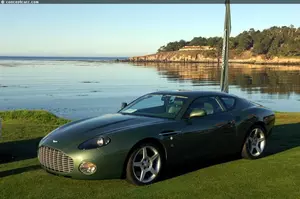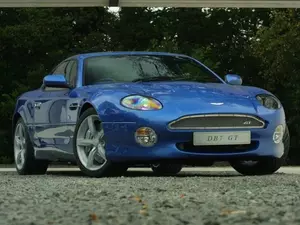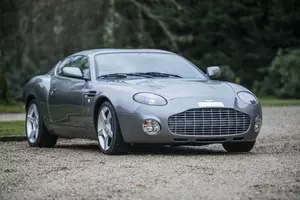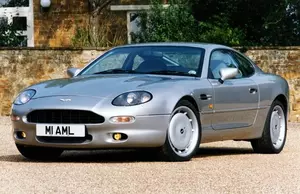


| Vehicle | Precise engine size | Difference from world average | Engine size to consumption ratio | Horsepower from 1 L | Engine size to 100 kg of weight |
|---|---|---|---|---|---|
| 5.9 V12 |
5.94 L (5935 cc) |
153% bigger | - | 74 hp from 1 L | 349 cc to 100 kg |
| Vehicle | 5.9 V12 |
|---|---|
| Precise engine size | 5.94 L (5935 cc) |
| Difference from world average | 153 bigger |
| Engine size to consumption ratio | - |
| Horsepower from 1 L | 74 hp from 1 L |
| Engine size to 100 kg of weight | 349 cc to 100 kg |

| Vehicle | Precise engine size | Difference from world average | Engine size to consumption ratio | Horsepower from 1 L | Engine size to 100 kg of weight |
|---|---|---|---|---|---|
| 5.9 i V12 48V |
5.94 L (5935 cc) |
153% bigger | - | 74 hp from 1 L | 330 cc to 100 kg |
| GTA 5.9 V12 |
5.94 L (5935 cc) |
153% bigger | - | 72 hp from 1 L | 330 cc to 100 kg |
| Vehicle | 5.9 i V12 48V |
|---|---|
| Precise engine size | 5.94 L (5935 cc) |
| Difference from world average | 153 bigger |
| Engine size to consumption ratio | - |
| Horsepower from 1 L | 74 hp from 1 L |
| Engine size to 100 kg of weight | 330 cc to 100 kg |
| Vehicle | GTA 5.9 V12 |
| Precise engine size | 5.94 L (5935 cc) |
| Difference from world average | 153 bigger |
| Engine size to consumption ratio | - |
| Horsepower from 1 L | 72 hp from 1 L |
| Engine size to 100 kg of weight | 330 cc to 100 kg |

| Vehicle | Precise engine size | Difference from world average | Engine size to consumption ratio | Horsepower from 1 L | Engine size to 100 kg of weight |
|---|---|---|---|---|---|
| 5.9 V12 |
5.94 L (5935 cc) |
153% bigger | - | 72 hp from 1 L | - |
| Vehicle | 5.9 V12 |
|---|---|
| Precise engine size | 5.94 L (5935 cc) |
| Difference from world average | 153 bigger |
| Engine size to consumption ratio | - |
| Horsepower from 1 L | 72 hp from 1 L |
| Engine size to 100 kg of weight | - |

| Vehicle | Precise engine size | Difference from world average | Engine size to consumption ratio | Horsepower from 1 L | Engine size to 100 kg of weight |
|---|---|---|---|---|---|
| 5.9i V12 48V |
5.94 L (5935 cc) |
153% bigger | - | 71 hp from 1 L | 330 cc to 100 kg |
| 5.9 V12 |
5.94 L (5935 cc) |
153% bigger | - | 72 hp from 1 L | 330 cc to 100 kg |
| Vehicle | 5.9i V12 48V |
|---|---|
| Precise engine size | 5.94 L (5935 cc) |
| Difference from world average | 153 bigger |
| Engine size to consumption ratio | - |
| Horsepower from 1 L | 71 hp from 1 L |
| Engine size to 100 kg of weight | 330 cc to 100 kg |
| Vehicle | 5.9 V12 |
| Precise engine size | 5.94 L (5935 cc) |
| Difference from world average | 153 bigger |
| Engine size to consumption ratio | - |
| Horsepower from 1 L | 72 hp from 1 L |
| Engine size to 100 kg of weight | 330 cc to 100 kg |

| Vehicle | Precise engine size | Difference from world average | Engine size to consumption ratio | Horsepower from 1 L | Engine size to 100 kg of weight |
|---|---|---|---|---|---|
| 5.9i V12 48V |
5.94 L (5935 cc) |
153% bigger | 457 cc to 1 mpg | 71 hp from 1 L | 312 cc to 100 kg |
| 5.9 V12 |
5.94 L (5935 cc) |
153% bigger | - | 72 hp from 1 L | 312 cc to 100 kg |
| 3.2 V6 |
3.23 L (3228 cc) |
37.6% bigger | - | 111 hp from 1 L | 190 cc to 100 kg |
| Vehicle | 5.9i V12 48V |
|---|---|
| Precise engine size | 5.94 L (5935 cc) |
| Difference from world average | 153 bigger |
| Engine size to consumption ratio | 457 cc to 1 mpg |
| Horsepower from 1 L | 71 hp from 1 L |
| Engine size to 100 kg of weight | 312 cc to 100 kg |
| Vehicle | 5.9 V12 |
| Precise engine size | 5.94 L (5935 cc) |
| Difference from world average | 153 bigger |
| Engine size to consumption ratio | - |
| Horsepower from 1 L | 72 hp from 1 L |
| Engine size to 100 kg of weight | 312 cc to 100 kg |
| Vehicle | 3.2 V6 |
| Precise engine size | 3.23 L (3228 cc) |
| Difference from world average | 37.6 bigger |
| Engine size to consumption ratio | - |
| Horsepower from 1 L | 111 hp from 1 L |
| Engine size to 100 kg of weight | 190 cc to 100 kg |

| Vehicle | Precise engine size | Difference from world average | Engine size to consumption ratio | Horsepower from 1 L | Engine size to 100 kg of weight |
|---|---|---|---|---|---|
| 3.2 V6 |
3.23 L (3228 cc) |
37.6% bigger | - | 111 hp from 1 L | 190 cc to 100 kg |
| Vehicle | 3.2 V6 |
|---|---|
| Precise engine size | 3.23 L (3228 cc) |
| Difference from world average | 37.6 bigger |
| Engine size to consumption ratio | - |
| Horsepower from 1 L | 111 hp from 1 L |
| Engine size to 100 kg of weight | 190 cc to 100 kg |